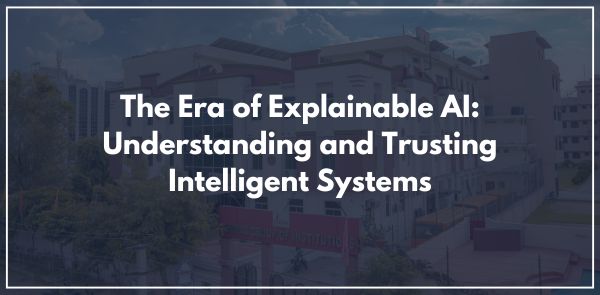
In the rapidly advancing field of artificial intelligence (AI), the quest for creating intelligent systems capable of making decisions has been accompanied by a growing demand for transparency and understanding. Enter the era of Explainable AI (XAI), a paradigm shift that prioritizes not just the accuracy of AI models but also the comprehensibility of their decision-making processes. This article explores the significance of Explainable AI, why it matters, and how it is shaping the landscape of intelligent systems.
Poddar International College, one of the best College in Jaipur provides best education in BCA and MCA along with other courses.
The Need for Explainability
As AI systems become more integrated into our daily lives, influencing decisions in finance, healthcare, criminal justice, and beyond, the question of trust and accountability becomes paramount. Traditional black-box AI models, while capable of delivering accurate results, often lack transparency, leaving users and stakeholders in the dark about how decisions are made. This opacity raises concerns about bias, ethics, and the potential for unintended consequences.
Understanding AI's Decision-Making
Explainable AI seeks to demystify the decision-making process of complex algorithms and neural networks. In essence, it aims to bridge the gap between the machine's reasoning and human comprehension. When an AI system can provide clear explanations for its outputs, users gain insights into why a particular decision was reached, fostering trust and allowing for more informed human-AI collaboration.
Applications in Healthcare
In the healthcare sector, where AI is increasingly employed for diagnostics, treatment recommendations, and patient care, explainability is crucial. Imagine a scenario where an AI model recommends a specific treatment plan for a patient. Explainable AI can provide detailed insights into the factors that influenced the recommendation, such as relevant medical literature, patient history, and diagnostic data. This not only helps medical professionals make informed decisions but also ensures accountability in critical healthcare interventions.
Addressing Bias and Fairness
One of the primary challenges in AI is the presence of bias in training data, leading to biased predictions and decisions. Explainable AI plays a pivotal role in identifying and addressing these biases by providing transparency into the decision-making process. Researchers and developers can scrutinize models to understand the source of bias and take corrective measures to ensure fairness and equity in AI applications.
Enhancing Financial Decision-Making:
In the financial industry, AI is widely employed for risk assessment, fraud detection, and investment strategies. Explainable AI is instrumental in elucidating the factors that contribute to financial decisions, helping stakeholders comprehend the rationale behind credit approvals, investment recommendations, and risk assessments. This transparency not only fosters trust but also allows for better-informed financial decision-making.
Regulatory Compliance and Accountability:
The advent of Explainable AI is closely aligned with regulatory efforts to ensure ethical and responsible AI deployment. Regulations such as the General Data Protection Regulation (GDPR) in Europe emphasize the right of individuals to understand the logic behind automated decisions. Explainable AI provides a means to comply with such regulations, offering transparency and accountability in AI systems, thus addressing legal and ethical considerations.
The students of IT of Poddar International College will be participating in Hackathon event to address and assist Rajasthan police in cybercrimes.
Challenges and Progress
While the importance of Explainable AI is clear, implementing it is not without challenges. Striking the right balance between model accuracy and interpretability is a delicate task. Researchers are actively developing techniques that provide both high-performance models and understandable explanations. The challenge lies in making AI systems transparent without compromising their effectiveness.
The students of Poddar International College have chance to showcase their Technical skills in annual IT event TechnioTrack.
The Future of Explainable AI
As the field of AI continues to evolve, the demand for Explainable AI is likely to grow. Researchers are exploring innovative approaches, including model-agnostic methods, interpretable machine learning models, and interactive visualization tools. The future holds the promise of AI systems that not only deliver accurate results but also empower users to trust, understand, and collaborate with intelligent machines seamlessly.
The students of Poddar International College are given opportunity to attend various seminars and workshops related to AI to sharpen their AI skills.
Conclusion
In the era of Explainable AI, the focus on transparency and understanding marks a significant step forward in the responsible development and deployment of intelligent systems. As AI becomes an integral part of various industries, the need for explainability is not just a technical requirement but a societal imperative. By unravelling the intricacies of AI decision-making, we pave the way for a future where humans and machines can collaborate with trust, accountability, and a shared understanding of the intelligent systems that shape our world.
Neeraj Sharma, a BCA student of Poddar International College, Jaipur identified a critical bug in Instagram, which was acknowledged by Instagram and he was listed 1st in India and 2nd in the world in the Facebook Hall of Fame along with cash prize money.